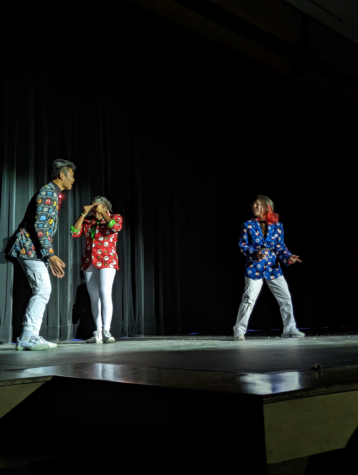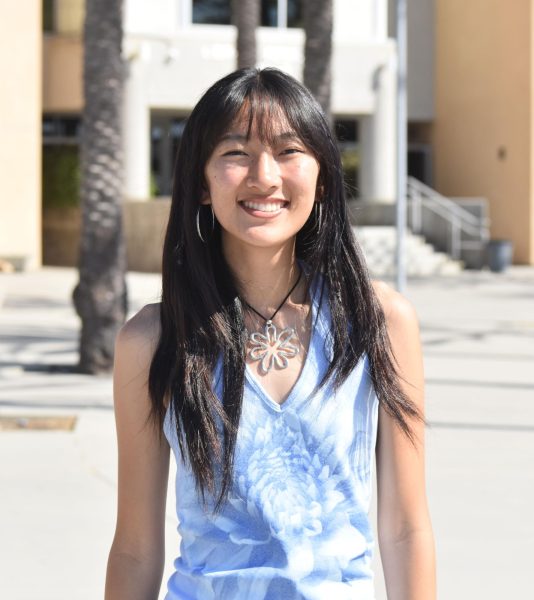Behind-the-scenes look at GOLD’s annual Winter show
December 16, 2022

While the audience only saw the program’s performance onstage, what kept it running was the show backstage. Band Director Mitchell Way and Associate Band Director Martin Fierro said the success of the show was owed to the leading members of the stage crew and the production team, who run the lights, sound and curtains.
During transitions within the show, the stage crew sets up upwards of 60 chairs, along with music stands for bigger sections like orchestra. In his first year as the head of stage crew, Egaran said a few struggles came with bearing responsibility over so many people, whereas last year he had a senior guide him through the process.
“There’s 20-40 people [in the stage crew],” Egaran said. “We set up the major ensembles in the show, [like] percussion, and we work with everything backstage. The hardest part is using all the people around you efficiently. [We have to] make sure that everything goes fast and efficiently so the audience doesn’t get bored.”
Due to the time crunch between planning, rehearsals, and the show, Egaran said stage crew’s priority is focusing on being quick and orderly with their work, but there is often a struggle with so many people constantly going on and off the stage and in the crew.
“It’s a very tight schedule and the more we communicate the faster it goes, but we have to cram all of this into two hours so time management is most important,” he said. “All of the people on stage crew are also performers so sometimes they’ll have to leave in order to perform. For some of these ensembles we don’t have enough people.”
However, even with stage crew’s efficiency, it takes time to set up a proper stage to accommodate the section that comes up next. Fierro said emcees are crucial in these transitions, keeping the show in a constant flow.
“They are telling a story and it’s guided along by our performances,” he said. “The emcees are the transition while the stage is getting set or while sets are being put together. It happens very quickly so you don’t really notice it.”
Despite so many people working on different parts of the show and in different places of the auditorium, Egaran said that when a problem arises, like the stage setup taking longer than the script for the emcee’s runs, everyone does what they can to solve it and cover for each other.
“There’s an effort from all of us,” Egaran said. “[For example,] production [would signal] to the emcees and they improvise,” Egaran said. “Some of the different production and stage crew members have walkie talkies, and that helps them time the transitions to make sure that the transitions aren’t too jarring.”
For Wiener, who is in charge of lights on the production team, having the show run smoothly in a cohesive way is most important. By giving timely light cues between each performance and communicating with stage crew members setting up while the emcees talk, she strives to maintain that flow.
“I use a blue flashlight to tell [the emcees] they need to improvise and another red flashlight to tell them to stop,” she said. “I have to do all the communication. It’s really important that the transitions look nice and I’m not making the emcees improvise a bunch.”
Fierro said that anything could happen in the middle of the show, so being flexible is necessary in keeping the show going.
“Things constantly go in a different direction,” Fierro said. “[We make sure] the ball keeps rolling, we keep going, [and] we do the best that we can to adjust.”
Way said the stage crew and the production team held irreplaceable roles in the show and their hard work is unlike any other in the whole production.
“The majority of the students in the program just go out there and play their piece and come off the stage,” he said. “The stage crew and the production team [are] literally the ones making the show happen.”
Way said that even though he and Fierro guide the students, the students are ultimately the ones who take initiative and make things happen. Wiener, for instance, takes extra time weeks prior to the Winter show to prepare enough before rehearsals begin.
“I always have to go a couple of weeks early for the shows and I spend around two hours programming the lights,” she said. “We have a couple meetings with [the directors] before and after the dress rehearsals [where] they meet with all the kids and talk about different adjustments for production and stage crew.”
Wiener said she was given a lot of freedom in deciding how the lights would look during the performances.
“There’s a lot of creative liberty,” she said. “The directors let me choose the color lights and how many colors there should be.”
Wiener goes through her own creative process to choose the light colors and takes pride in the result when she gets to see the production as a whole.
“I listen to the song and try to imagine the mood so I can get an idea for the light color,” she said. “It’s really nice to see it come together because when you sit in the booth you get to see the whole show.”


